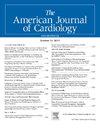Impact of Intensified Outpatient Follow-Up on Rehospitalization After Transcatheter Aortic Valve Implantation: Results From the HOSPITAVI Trial
IF 2.3
3区 医学
Q2 CARDIAC & CARDIOVASCULAR SYSTEMS
引用次数: 0
Abstract
Patients undergoing transcatheter aortic valve implantation (TAVI) are at increased risk of rehospitalization in the early period after discharge from TAVI. The HOSPITAVI study aimed to compare the impact of a standard versus intensified outpatient follow-up on rehospitalization rates within 90 days after TAVI discharge. Patients were 1:1 randomized to either a standard or intensified outpatient follow-up after TAVI discharge. The primary endpoint was the 90-day hospital rehospitalization rate. In total, 300 patients were included: 150 patients were randomized to standard follow-up and 150 patients to intensified outpatient follow-up. The study population had a median age of 79 years, a median EuroSCORE II of 2.9%, and 72% were discharged the day after TAVI. Within 90 days after discharge, the mean number of all-cause hospital readmissions per patient was 0.44 versus 0.35 (HR 0.8 [95% CI, 0.6–1.2], p = 0.23) in the standard versus intensified group, respectively. The mean number of cardiovascular (CV) readmissions per patient was 0.27 versus 0.15 (HR 0.6 [95% CI, 0.4–1.0], p = 0.04) in the standard versus intensified group, respectively. This resulted in a mean number of CV readmission days per patient of 1.52 days versus 0.49 days within the first 90 days in the standard versus intensified group, respectively (p < 0.05). Following TAVI discharge, there was no significant difference in all-cause rehospitalization rates using a standard versus intensified outpatient follow-up approach. However, an intensified outpatient follow-up reduces the burden of early CV rehospitalization after TAVI discharge. (Rehospitalization after transcatheter aortic valve implantation [HOSPITAVI]; NCT05670041).
加强门诊随访对经导管主动脉瓣置入术后再住院的影响:来自hospitali试验的结果
背景:经导管主动脉瓣植入术(TAVI)患者出院后早期再次住院的风险增加。目的:hospitali研究旨在比较标准门诊随访与强化门诊随访对TAVI出院后90天内再住院率的影响。方法:患者按1:1随机分组,在TAVI出院后接受标准或强化门诊随访。主要终点是90天的再住院率。结果:共纳入300例患者,其中150例随机分为标准随访组,150例随机分为强化门诊随访组。研究人群的中位年龄为79岁,中位EuroSCORE II为2.9%,72%的患者在TAVI后第二天出院。出院后90天内,标准组和强化组平均每位患者全因再入院次数分别为0.44次和0.35次(HR 0.8 [95%CI: 0.6-1.2], P=0.23)。标准组和强化组的平均心血管再入院数分别为0.27例和0.15例(风险比0.6 [95%CI: 0.4-1.0], P=0.04)。这导致标准组和强化组在前90天内每位患者的平均CV再入院天数分别为1.52天和0.49天(p结论:TAVI出院后,采用标准和强化门诊随访方法的全因再住院率无显著差异。然而,加强门诊随访减少了TAVI出院后早期CV再住院的负担。经导管主动脉瓣置入术后再住院[医院];NCT05670041)。
本文章由计算机程序翻译,如有差异,请以英文原文为准。
求助全文
约1分钟内获得全文
求助全文
来源期刊

American Journal of Cardiology
医学-心血管系统
CiteScore
4.00
自引率
3.60%
发文量
698
审稿时长
33 days
期刊介绍:
Published 24 times a year, The American Journal of Cardiology® is an independent journal designed for cardiovascular disease specialists and internists with a subspecialty in cardiology throughout the world. AJC is an independent, scientific, peer-reviewed journal of original articles that focus on the practical, clinical approach to the diagnosis and treatment of cardiovascular disease. AJC has one of the fastest acceptance to publication times in Cardiology. Features report on systemic hypertension, methodology, drugs, pacing, arrhythmia, preventive cardiology, congestive heart failure, valvular heart disease, congenital heart disease, and cardiomyopathy. Also included are editorials, readers'' comments, and symposia.
 求助内容:
求助内容: 应助结果提醒方式:
应助结果提醒方式:


